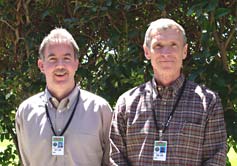

Thursday - August 30, 2007
SLAC Today is
available online at:
http://today.slac.stanford.edu
In this issue:
A Message from Bob McCallum and Kyle Turner
Science Today: The Chemical Form of Mercury in the Fish We Eat
Something A-Maize-ing
 |
 |
|
Thursday - August 30, 2007 |
A Message from Bob McCallum and Kyle Turner
Bob McCallum (left) and Kyle Turner.
In his July 17, 2007 All Hands presentation to the SLAC staff, Jonathan Dorfan said: "World-class science requires world-class management and operations (M&O) support. We (SLAC) currently lack a portfolio of business and support systems whose excellence matches that of the science, and thus we are putting the achievement of our scientific and technology mission at risk." As you are aware, SLAC has asked us, McCallum-Turner Inc., to help the laboratory determine what changes are essential and also to help develop a staged implementation plan. To focus this process, we have targeted 11 specific areas of SLAC's M&O to examine further. A team of peers from across the country, each a subject matter expert in one of the 11 areas, has already begun this process. Their interface with the laboratory is through SLAC points of contact (POCs). Each POC is directly supported by a team from SLAC. Although we will research each of the 11 target areas extensively over the next several months, it is simply not possible for us to gain the depth of knowledge already held by those who work at the laboratory. Each employee is an expert who possesses a strong sense of what works and what needs improvement in his or her specific area. Because of this, we ask SLAC employees to offer their comments and suggestions on how M&O works (or doesn't work) in the areas where they have experience. Employees can contact us with ideas, comments or suggestions via email at mccallum.turner@slac.stanford.edu or by phone at (650) 926-6200. Alternatively, employees can contact the POC working in the area of their concerns. A list of POCs is available online. To help clarify matters, SLAC has created a Sharepoint website. This site contains status updates, information on how to contact each area's lead subject matter expert and POC, and further information of what each of the 11 areas encompasses. (Click on the links in the "SLAC M&O Points of Contact" box on the Sharepoint website for more information about each focus area.) Additionally, future articles published in SLAC Today will further discuss each area's focus. We hope that these tools will help make this process as comprehensive, inclusive, successful and rewarding as possible. We look forward to working with everyone at SLAC on this important project. |
||
|
|
||
 The Chemical Form
|
Something A-Maize-ing
People passing by the southwest corner of the Heavy Fabrication Building this summer may have noticed a surprising juxtaposition: several stalks of corn growing in this otherwise industrial area. A small garden, which also includes bell pepper, pea, basil, and jalapeno pepper plants, has been cultivated there by SLAC employee Angela Garcia since late April. "The deer on site ate the bell pepper and pea plants," said Garcia. "They started to eat the jalapeno plants too, but stopped after a few bites." For whatever reason, the deer also stayed away from the stalks of corn. Garcia has harvested several ears along with many jalapeno peppers, and says they taste great. The vegetables grow in several plant boxes, one of which was already serendipitously sitting outside the Heavy Fabrication Building. Garcia got two more from fellow Mechanical Fabrication Department employees Craig Jordan and Eamon Lacey, who suggested she start the small garden project. "I figured, 'why not?'" said Garcia. "There's always room on the table for fresh veggies." |
Events (see all | submit)
Access (see all)
Announcements
|
| | ||
|
|
||
 <%
Response.AddHeader "Last-modified", getArticleDate()
'Response.AddHeader "Last-modified","Mon, 01 Sep 1997 01:03:33 GMT"
'Monday, December 06, 2010
%>
<%
Response.AddHeader "Last-modified", getArticleDate()
'Response.AddHeader "Last-modified","Mon, 01 Sep 1997 01:03:33 GMT"
'Monday, December 06, 2010
%>View online at http://today.slac.stanford.edu/. |
||